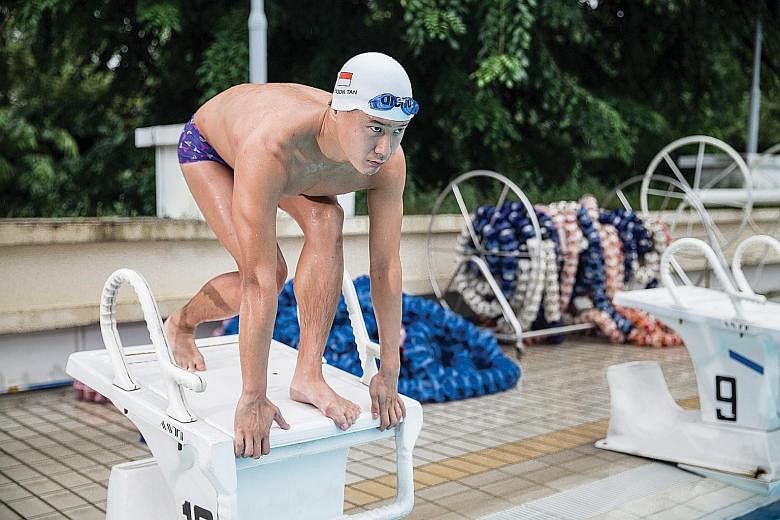It is said it takes a village to raise a child. Today, it also takes a village or, at the least, a team of dedicated experts to help prepare an athlete for a sporting event.
On top of coaches, the athlete can now count on support from various sports science experts to optimise his performance.
Take Benson Tan, 24, a para- swimmer with attention deficit hyperactivity disorder (ADHD). He will be taking part in the 8th Asean Para Games, to be held here next month.
The retail sales assistant has benefited from the partnership between the Singapore Disability Sports Council and the Singapore Sports Institute (SSI).
He has received help from SSI experts such as biomechanists, nutritionists, strength and conditioning coaches, physiologists and psychologists to work on specific areas.
For instance, swimmers need the correct fuel to improve their performance. Nutrition impacts a swimmer's performance in three ways, said Dr Kirsty Fairbairn, head and senior sports dietitian at SSI's Sports Science Centre.
It provides the nutrients that the body needs to cope with the high demands of training.
Eating the right food will also create the ideal body composition for performance. This refers to percentages of fat, bone, water and muscle in human bodies.
Self-esteem and self-belief are also boosted when athletes know that they are making good choices for themselves, said Dr Fairbairn.
To help nutritionists prepare dietary advice for para-swimmers, 14 of them were tested for how much energy they expended while resting. This gave nutritionists a more accurate estimate of a swimmer's daily energy requirements.
Para-swimmers need to eat the same diet as any able-bodied athlete, she said.
-
Try these moves
-
LATERAL PULL-DOWN

Pull the cable bar down towards the upper chest. Benson is pulling weights of 80kg. Return to the original position, where the arms and shoulders are fully extended. Repeat five times. Do three sets.
CABLE PULL-DOWN

In a standing position, grab both cable handles. Pull the cables down towards the lower back. Return to the starting position.
Repeat three to five times. Do three sets.
LEG PRESS

Place both legs shoulder-width apart on the platform of the leg press machine. Ensure that the heels are flat against the platform.
Your legs should form a 90-degree angle at the knees, which should be in line with the feet.
Pushing with the heels of the feet, press against the platform until your legs are fully extended.
Return to the original position.
Repeat three to five times. Do three sets.
RESISTANCE BAND SQUAT JUMP

In a squat position, place your left foot forward, and the resistance bands around your shoulders. Lower the body slightly and jump as high as possible. Switch your leg positions in the air - land with the right foot forward in a squat position. Repeat three to five times. Do three sets.
BACK EXTENSION

Place your pelvis against the lower pelvis support on an extension bench. Your feet should be firmly hooked on the foot pads. Hold weights of 2.5kg in your hands, and stretch your arms forward. Start with your upper body at a lower level than that of your lower body. Without moving your lower body, raise your upper body until your body forms a straight line. Slowly return to the starting position. Keep your back straight throughout. Repeat three to five times. Do three sets.
Strengthening one's upper back muscles and arms will give a swimmer more force when pulling during each stroke. Meanwhile, stronger leg strength gives a person more power when he dives into the pool and turns at the wall. Mr Danny Lum, a strength and conditioning coach at the Singapore Sports Institute, gives examples of strengthening exercises. Benson Tan, 24, a para-swimmer, demonstrates.
"Once we have an estimate of the energy requirements, we evaluate the times in the day that our athletes need to eat carbohydrates in order to train well and to recover from training," said Dr Fairbairn.
The nutritionists also calculate the percentage of energy in the swimmers' diets which should come from carbohydrate, protein and fat.
The swimmers will eat that way until they obtain the body composition they want. "We use sports performance as a motivator to teach our athletes how to eat well and retrain their taste buds to enjoy healthy food," said Dr Fairbairn.
IMPROVING SWIM SPEEDS
Besides food and nutrition, swimmers also get support to improve their speeds.
Data on the swimmer's performance is recorded using above-water and underwater video footage.
A biomechanist then uses the swim segment split times to calculate the swimmer's pace over a series of laps; the speed he is swimming in still water, known as pure swim velocity; and stroke dynamics - how a swimmer executes the pull, kick and core movements within the given stroke.
With this information, Mr Ryan Hodierne, sports biomechanist at the SSI's Sports Science Centre, generates a swim profile of swim speed, distance per stroke and stroke tempo for each swimmer's race.
During training sessions, the stroke mechanics are broken down and areas where the swimmer can make marginal gains are identified, he added. For example, the swimmer may orientate his hand differently for better propulsion, or improve his body streamlining for greater swimming efficiency.
The body also needs tuning, like a good car, in order to keep the engine running smoothly.
This can be achieved with warming up or conditioning exercises.
Dynamic stretching, which is moving the body freely through its available range of motion, is now favoured over static stretching, said Mr Scott Vanderput, an associate strength and conditioning coach at the Sports Science Centre.
Dynamic warm-ups also inject an element of variety to the conditioning regimen and help to enhance the swimmer's motor control.
Warm-up exercises should be simple and done with minimal equipment so that they can be kept consistent and done anywhere, said Mr Vanderput.
Next, swimmers need to recover from their training and races.
The two most important things to assist any swimmer's recovery are adequate sleep and nutrition, said Mr Carl Douglas Bradford, associate sports physiologist at the Sports Science Centre.
Many of the body's natural recovery and repair processes occur during sleep. Good-quality sleep - ideally for more than seven hours - is therefore vital.
Doing an active cool-down is also effective, and has been regularly shown to help reduce muscle soreness and fatigue after exercise, he said.
A good active cool-down might look like warm-up exercises in reverse. The athlete starts off with more energy and gradually decreases the intensity, he added.
Many swimmers like to "swim down", meaning they cool down in the pool. They go through specific movements or technique drills as part of their cool-down.
But cooling down on land, such as by jogging or cycling, should be just as effective for anyone who does not enjoy getting back in the water, said Mr Bradford.
Other recovery methods include ice baths, water immersion, electronic muscle stimulation and massages.
There is mixed research on what works. Athletes can try the various recovery methods to find out which suits them the most, he added.
COPING WITH ANXIETY
For both able-bodied and para- athletes, a customised routine that provides them with a checklist to follow before a major competition helps them cope with anxiety better, said Mr Joshua Chua, associate sports psychologist at the Sports Science Centre.
The difference with para-athletes like Benson, however, is in the amount of effort needed to engage with them.
"For instance, with Benson who has ADHD, it is best that his mother is around when I talk to him," said Mr Chua.
"This ensures that there is someone whom he trusts who will be able to reinforce the messages."
All the support has helped Benson, who started working with SSI in May last year.
"I have managed to improve my performance in the pool," he said.
One of the key components that has helped his progress is the strength and conditioning training sessions he has been attending twice weekly.
"These sessions have helped to strengthen my lower limbs, giving me more power in my kicks and turns. I also managed to shave two seconds off my personal best time in my 100m freestyle event," he said.
The swimmer, who started competing at age 18, will be taking part in six events - the 50m, 100m and 200m free, 50m fly, 100m back and 100m breaststroke - at the 8th Asean Para Games.
He won a gold and set the meet record at the 7th Asean Para Games in the 100m free. He also won two silvers in the 50m butterfly and 50m freestyle at the same meet.


